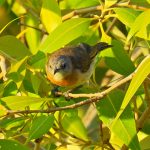RUFOUS-BANDED HONEYEATER
The Rufous-banded honeyeater is adorned with a soft, grey-brown plumage that blends seamlessly with its natural surroundings. Its most distinctive feature is the rufous, or reddish-brown, band that graces its chest, serving as a vibrant contrast to its white throat and underparts. Its eyes are bright and curious, always on the lookout for the next adventure. These birds are highly social, often seen in small flocks, which enhances their foraging efficiency and provides protection against predators. They are known for their acrobatic flight, darting swiftly between branches and flowers, a testament to their agility and adaptability.
This honeyeater is primarily found in northern Australia, from the Kimberley region in Western Australia, across the Northern Territory, and into Queensland. It thrives in mangroves, open woodlands, and shrublands, often near water sources. The bird’s adaptability allows it to flourish in varied environments, from coastal regions to inland areas.
The Rufous-banded honeyeater is not just a visual delight but an auditory one as well. Its call is a series of melodious, high-pitched notes that can be heard echoing through its habitat. These calls are used for communication, particularly during the breeding season, to attract mates and signal territory.
As its name suggests, the honeyeater’s diet predominantly consists of nectar, which it skillfully extracts from flowers using its slender, curved bill. It plays a crucial role in pollination, helping to maintain the health and diversity of its ecosystem. However, it is not averse to a bit of variety, supplementing its diet with insects and other small invertebrates, providing essential protein and nutrients.
The breeding season for the Rufous-banded honeyeater typically occurs during the warmer months, from August to February. During this time, the birds engage in intricate courtship displays. They build small, cup-shaped nests, often hidden among foliage to protect their eggs from predators. Both parents share the responsibility of caring for their young, ensuring their offspring have the best start in life.
While specific data on the longevity of the Rufous-banded honeyeater is limited, many small bird species in similar environments tend to live for several years, with survival often dependent on environmental factors and predation.
Currently, the Rufous-banded honeyeater is listed as Least Concern by the International Union for Conservation of Nature (IUCN). This status reflects its stable population across its range. However, like many native species, it faces threats from habitat loss and environmental changes, underscoring the importance of ongoing conservation efforts.





